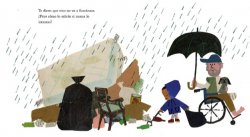
From Something, Someday by Amanda Gorman & Christian Robinson © 2023 by Viking

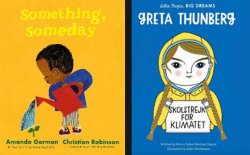
The Child as Activist
Review of Something, Someday by Amanda Gorman (author) and Christian Robinson (artist) (New York: Viking, 2023) and Greta Thunberg by Maria Isabel Sánchez Vegara (author) and Anke Weckmann (artist) (London: Frances Lincoln Children’s Books, 2020).
Reviewed By Maughn Rollins Gregory
Aristotle taught about a special kind of knowledge that is different from knowing about the way things are. What he called phronesis or practical wisdom is the ability to figure out the right or the best thing to do in a particular, unique situation. Two books for young children show us that pretty often, doing the right thing involves recognizing and criticizing something wrong in the world around us, and that children sometimes have more practical wisdom than adults.
You’re scared.
And confused.
You’re angry.
The first thing to notice about the vibrant picture book Something, Someday (Viking, 2023) is how the artwork and text continually separate and fuse, like oil and vinegar in a salad dressing shaker. The art, by Newbery Medalist Christian Robinson, tells the story of a particular, Black child, in a particular place and time (an urban apartment complex), confronting a particular problem (the grounds are strewn with garbage), who tries to do something about it (remove the garbage and plant a vegetable and flower garden), who enlists the help of others and meets particular setbacks (the first plants die), but ultimately succeeds in a particularly satisfying way (a community meal made from the garden produce).

From Something, Someday by Amanda Gorman & Christian Robinson © 2023 by Viking
The narrative, by the first National Youth Poet Laureate, Amanda Gorman, is detached from any such particularity. It is, in fact, a string of affirmational aphorisms.
[…]
You’re told to sit and wait,
But you know people
Have already waited
Too long.
The second thing to notice is that Gorman’s text is addressed to “you,” the reader – but now text and image come together to make clear that in this case, “you” is a child. Here are some of the affirmations she delivers to “you” (my paraphrases):
Taken together, they make a pretty good formula for practical wisdom. Except that, as Aristotle pointed out, practical wisdom isn’t formulaic. To be practically wise is to be able to figure out how to act (and not act) in situations that are new and unique, that change over time, and are unpredictable. So, there is always some intellectual and emotional work to do. Maybe I am too small to take this on – am I? Maybe this really is none of my business – is it? Who can I really count on to understand what I’m trying to do and help me do it?
Two of the founders of philosophy for children, Ann Margaret Sharp and Gareth B. Matthews, wrote that when children think philosophically, they inevitably will, and unquestionably should engage in social criticism. Indeed, sensitivity to injustice and ugliness is a philosophical capacity that tends to be keenest in childhood. Though we sometimes shield children from harsh realities, we also need to nurture their ethical, political, and aesthetic impulses.
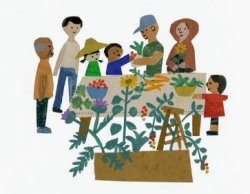
From Something, Someday by Amanda Gorman & Christian Robinson © 2023 by Viking
In some ways, the bio-board-book Greta Thunberg, by author Maria Isabel Sánchez Vegara and artist Anke Weckmann (Frances Lincoln Children’s Books, 2020) is a stark contrast to Something, Someday. The wrong it shows children confronting is global rather than local; the protagonist is strident rather than subtle; it doesn’t end happily; and it is a true story. In other ways, the two books tell the same story: a child recognizes an important environmental problem, is initially discouraged from taking action by the adults in their life, comes up with a strategy to address the problem, and is joined by like-minded others to push that strategy as far as they can.
Part of the genius of Greta Thunberg is how both text and artwork convey Greta’s life and her life’s message in ways that are detailed and complex, but accessible for young readers and those being read to. Older children and adults can read Thunberg’s own words in a 2019 book of her collected speeches, in which now, the “you” is the adult:
[…]
Adults keep saying: ‘We owe it to the young people to give them hope.’
But Greta hadn’t planned on becoming an internationally-recognized political gadfly. She learned about climate change in school, at the age of eight, and her first accomplishment was to persuade her parents to make lifestyle changes to reduce their carbon footprint. When she was fifteen, Greta won a writing competition about the environment and her essay was published in the Swedish newspaper Svenska Dagbladet. She was contacted by other activists, who discussed ideas for bringing attention to the climate crisis. Greta liked the idea of a school strike, inspired by the school walkouts organized by the students of Marjory Stoneman Douglas High School in Parkland, Florida, to protest legislative inaction on gun control after the mass shooting at their school. But Greta couldn’t interest anyone else in the idea, so she planned her own, one-child strike. On August 20, 2018, instead of attending school, she sat down outside the Swedish Parliament and handed out fliers listing facts about the climate crisis.
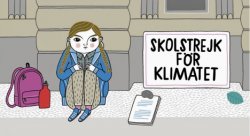
From Greta Thunberg by Maria Isabel Sánchez Vegara & Anke Weckmann © 2020 Frances Lincoln Children’s Books
Skolstrejk för klimatet = School Strike for Climate
One of the challenges Greta faced came from her own parents, who “did not support the idea of school striking and said that if I were to do this I would have to do it completely by myself and with no support from them” – which she did. She posted about her school strike on social media and contacted some local journalists, whose articles helped her social media campaign go viral. Before long, children across Sweden and in many other countries were joining Greta in Friday School Strikes. The next year, Greta sailed on a carbon-free yacht to speak to the 2019 UN Climate Action Summit, where she told some difficult truths:
This speech brought Greta’s message to even more young people around the world, who began local Friday School Strikes and massive, multi-city protests with over a million students each. In response to this, Greta said, “If a few children can get headlines all over the world just by not going to school for a few weeks, imagine what we all could do together if we wanted to. So everyone out there: it is now time for civil disobedience.”
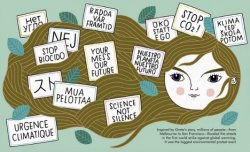
From Greta Thunberg by Maria Isabel Sánchez Vegara & Anke Weckmann © 2020 Frances Lincoln Children’s Books
Children comprise a disenfranchised minority group. As Greta explained, “Many of us who will be affected the most by this crisis, people like me, are not allowed to vote. Nor are we in a position to shape the decisions of business, politics, engineering, media, education or science.” That children should be given that position is stipulated in Article 12 of in the United Nations’ Convention on the Rights of the Child (1989):
This is, in part, why Matthews and others have called for children’s philosophical thinking and writing to be given public venues. It is also an impetus behind the contemporary “action civics” education movement, which invites young people to read their world critically and find ways to make differences that matter to them.
Greta’s story also demonstrates some of the challenges and gifts that neurodiverse children bring to activism. For almost four years before her school strike campaign, Greta suffered from depression and selective mutism. She stopped playing the piano and lost 22 lbs. over two months when she refused to eat much (portrayed in the book by Vegara and Weckmann). She was diagnosed with Asperger’s syndrome, which she characterized as “not a disease, it’s a gift,” and a “superpower,” because of how it enables her to focus, to see issues as “black and white,” and to act on her own sometimes, without social (and sometimes without family) support.
Neither Something, Someday nor Greta Thunberg provides a formula for child activism. What these books offer is the invitation for children to be conscientious – to follow their conscience – and to develop practical wisdom in working for social change. Indeed, the two books can be used together, to help us think about how working for social change depends on the context: What will we count as progress? What rules might we have to break? How can we try to get others to pay attention? How will we answer those who say we’re too small, that it’s none of our business, or that what we’re trying won’t work? What will we do when this work makes us confused, afraid, or angry? These books also prod adults to think of social change as children’s work, and to join them in honest appraisals of troubling situations, in strategizing, and in risk assessment. “Imagine what we all could do together if we wanted to.”
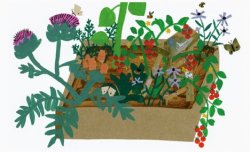
From Something, Someday by Amanda Gorman & Christian Robinson © 2023 by Viking
Bibliography
Facing History and Ourselves (2019) How the Parkland Students Pulled off a Massive National Protest
in Only 5 Weeks. URL = https://www.facinghistory.org/resource-library/how-parkland-students-
pulled-massive-national-protest-only-5-weeks.
Leonard, Jill (2020) Who is Greta Thunberg? Penguin Workshop.
Thunberg, Greta (2019) No One Is Too Small to Make a Difference. Penguin Books.